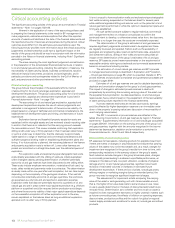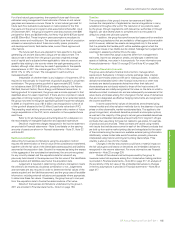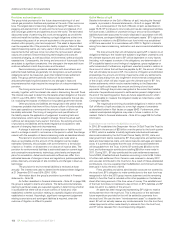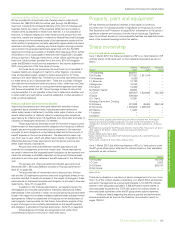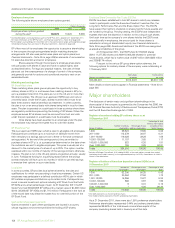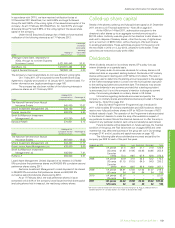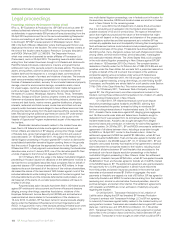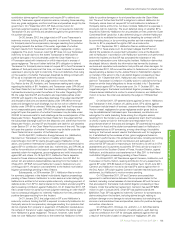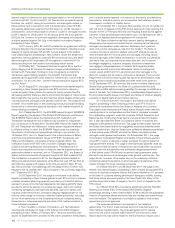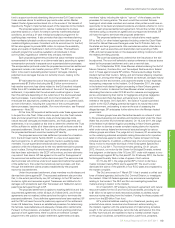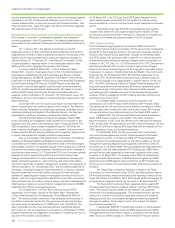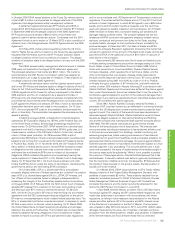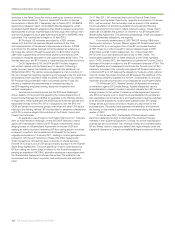BP 2011 Annual Report Download - page 166
Download and view the complete annual report
Please find page 166 of the 2011 BP annual report below. You can navigate through the pages in the report by either clicking on the pages listed below, or by using the keyword search tool below to find specific information within the annual report.
164 BP Annual Report and Form 20-F 2011
Additional information for shareholders
liquidity, shareholder returns and/or implementation of its strategic agenda,
particularly in the US. These potential liabilities may continue to have a
material adverse effect on the group’s results and financial condition. See
Financial statements – Note 2 on pages 190-194 for information regarding
the financial impact of the Incident.
Investigations and reports relating to the Deepwater Horizon oil spill
BP is subject to a number of investigations related to the Incident by
numerous agencies of the US government. The related published reports
are available on the websites of the agencies and commissions referred to
below.
On 11 January 2011, the National Commission on the BP
Deepwater Horizon Oil Spill and Offshore Drilling (National Commission),
established by President Obama, published its report on the causes of the
Incident and its recommendations for policy and regulatory changes for
offshore drilling. On 17 February 2011, the National Commission’s Chief
Counsel published a separate report on his investigation that provides
additional information regarding the causes of the Incident.
In a report dated 20 March 2011, with an Addendum dated
30 April 2011, the Joint Investigation Team (JIT) for the Marine Board of
Investigation established by the US Coast Guard and Bureau of Ocean
Energy Management (BOEMRE) issued the Final Report of the Forensic
Examination of the Deepwater Horizon Blowout Preventer (BOP) prepared
by Det Norske Veritas (BOP Report). The BOP Report concludes that
the position of the drill pipe against the blind shear rams prevented the
BOP from functioning as intended. Subsequently, BP helped to sponsor
additional BOP testing conducted by Det Norske Veritas under court
auspices, which concluded on 21 June 2011. BP continues to review the
BOP Report and is in the process of evaluating the data obtained from the
additional testing.
On 22 April 2011, the US Coast Guard issued its report (Maritime
Report) focused upon the maritime aspects of the Incident. The Maritime
Report criticizes Transocean’s maintenance operations and safety culture,
while also criticizing the Republic of the Marshall Islands – the flag state
responsible for certifying Transocean’s Deepwater Horizon vessel.
The US Chemical Safety and Hazard Investigation Board (CSB)
is also conducting an investigation of the Incident that is focused on the
explosions and fire, and not the resulting oil spill or response efforts. The
CSB is expected to issue a single investigation report in 2012 that will
seek to identify the alleged root cause(s) of the Incident, and recommend
improvements to BP and industry practices and to regulatory programmes
to prevent recurrence and mitigate potential consequences.
Also, at the request of the Department of the Interior, the National
Academy of Engineering/National Research Council established a
Committee (Committee) to examine the performance of the technologies
and practices involved in the probable causes of the Incident and to identify
and recommend technologies, practices, standards and other measures to
avoid similar future events. On 17 November 2010, the Committee publicly
released its interim report setting forth the Committee’s preliminary
findings and observations on various actions and decisions including well
design, cementing operations, well monitoring, and well control actions.
The interim report also considers management, oversight, and regulation of
offshore operations. On 14 December 2011, the Committee published its
final report, including findings and recommendations. A second, unrelated
National Academies Committee will be looking at the methodologies
available for assessing spill impacts on ecosystem services in the Gulf of
Mexico, with a final report expected in late 2012 or early 2013, and a third
National Academies Committee will be studying methods for assessing the
effectiveness of safety and environmental management systems (SEMS)
established by offshore oil and gas operators.
On 10 March 2011, the Flow Rate Technical Group (FRTG),
Department of the Interior, issued its final report titled “Assessment
of Flow Rate Estimates for the Deepwater Horizon/Macondo Well Oil
Spill.” The report provides a summary of the strengths and limitations of
the different methods used by the US government to estimate the flow
rate and a range of estimates from 13,000 b/d to over 100,000 b/d. The
report concludes that the most accurate estimate was 53,000 b/d just
prior to shut in, with an uncertainty on that value of ±10% based on FRTG
collective experience and judgement, and, based on modelling, the flow on
day one of the Incident was 62,000 b/d.
On 18 March 2011, the US Coast Guard ISPR team released its final
report capturing lessons learned from the Incident as well as making
recommendations on how to improve future oil spill response and recovery
efforts.
Additionally, since April 2010, BP representatives have testified
multiple times before the US Congress regarding the Incident. BP has
provided documents and written information in response to requests from
Members, committees and subcommittees of the US Congress.
Other legal proceedings
The US Federal Energy Regulatory Commission (FERC) and the US
Commodity Futures Trading Commission (CFTC) are currently investigating
several BP entities regarding trading in the next-day natural gas market at
Houston Ship Channel during September, October and November 2008.
The FERC Office of Enforcement staff notified BP on 12 November 2010
of their preliminary conclusions relating to alleged market manipulation in
violation of 18 C.F.R. Sec. 1c.1. On 30 November 2010, CFTC Enforcement
staff also provided BP with a notice of intent to recommend charges
based on the same conduct alleging that BP engaged in attempted market
manipulation in violation of Section 6(c), 6(d), and 9(a)(2) of the Commodity
Exchange Act. On 23 December 2010, BP submitted responses to the
FERC and CFTC November 2010 notices providing a detailed response
that it did not engage in any inappropriate or unlawful activity. On 28 July
2011, the FERC staff issued a Notice of Alleged Violations stating that it
had preliminarily determined that several BP entities fraudulently traded
physical natural gas in the Houston Ship Channel and Katy markets
and trading points to increase the value of their financial swing spread
positions. Other investigations into BP’s trading activities continue to be
conducted from time to time.
On 23 March 2005, an explosion and fire occurred in the
isomerization unit of BP Products North America’s (BP Products) Texas
City refinery as the unit was coming out of planned maintenance. Fifteen
workers died in the incident and many others were injured. BP Products
has resolved all civil injury claims arising from the March 2005 incident.
In March 2007, the US Chemical Safety and Hazard Investigation
Board (CSB) issued a report on the incident. The report contained
recommendations to the Texas City refinery and to the board of directors
of BP. In May 2007, BP responded to the CSB’s recommendations. BP and
the CSB will continue to discuss BP’s responses with the objective of the
CSB’s agreeing to close out its recommendations.
On 25 October 2007, the DoJ announced that it had entered
into a criminal plea agreement with BP Products related to the March
2005 explosion and fire. On 4 February 2008, BP Products pleaded
guilty, pursuant to the plea agreement, to one felony violation of the risk
management planning regulations promulgated under the US Clean Air
Act (CAA) and on 12 March 2009, the court accepted the plea agreement.
In connection with the plea agreement, BP Products paid a $50-million
criminal fine and was sentenced to three years’ probation which is set
to expire on 12 March 2012. Compliance with a 2005 US Occupational
Safety and Health Administration (OSHA) settlement agreement (2005
Agreement) and a 2006 agreed order entered into by BP Products with
the Texas Commission on Environmental Quality (TCEQ) are conditions of
probation.
The Texas Office of Attorney General, on behalf of the Texas
Commission on Environmental Quality (TCEQ), has filed a petition against
BP Products asserting certain air emissions and reporting violations at the
Texas City refinery from 2005 to 2010. BP Products settled this lawsuit by
an Agreed Final Judgment entered by the court on 20 December 2011.
The Texas Attorney General filed a separate petition against BP
Products asserting emissions violations relating to a 6 April 2010 flaring
event. This lawsuit was also settled by the Agreed Final Judgment
mentioned in the preceding paragraph. This emissions event is also the
subject of a number of civil suits by many area workers and residents
alleging personal injury and property damages and seeking substantial
damages. In addition, this emissions event is the subject of a federal
governmental investigation.
In September 2009, BP Products filed a petition to clarify specific
required actions and deadlines under the 2005 Agreement with OSHA.
That agreement resolved citations issued in connection with the March
2005 Texas City refinery explosion. OSHA denied BP Products’ petition.


